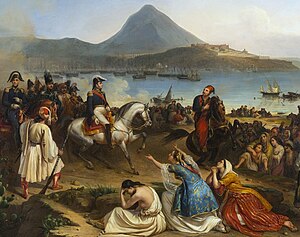
Back حملة موريا Arabic Morea-Expedition German Εκστρατεία του Μοριά Greek Expedición de Morea Spanish Expédition de Morée French Campagna di Morea Italian 모레아 원정 Korean د موریا لښکرکشي Pashto/Pushto Expediția din Moreea Romanian Третья Архипелагская экспедиция Russian
| Expedition of the Morea | |||||||
|---|---|---|---|---|---|---|---|
| Part of the Greek War of Independence | |||||||
 Meeting between General Maison and Ibrahim Pasha in Navarino in September 1828 (detail) (by Jean-Charles Langlois, 1838) | |||||||
| |||||||
| Belligerents | |||||||
|
|
| ||||||
| Commanders and leaders | |||||||
|
- Nicolas Joseph Maison (military expedition) - Jean Baptiste Bory de Saint-Vincent (scientific expedition) | - Ibrahim Pasha of Egypt | ||||||
| Casualties and losses | |||||||
| 1,500 dead | unknown | ||||||
The Morea expedition (French: Expédition de Morée) is the name given to the land intervention of the French Army in the Peloponnese between 1828 and 1833, at the time of the Greek War of Independence, with the aim of expelling the Ottoman-Egyptian occupation forces from the region . It was also accompanied by a scientific expedition mandated by the French Academy.
After the fall of Messolonghi in 1826, the Western European powers decided to intervene in favour of revolutionary Greece. Their primary objective was to force Ibrahim Pasha, the Ottoman Empire's Egyptian ally, to evacuate the occupied regions and the Peloponnese. The intervention began when a Franco-Russo-British fleet was sent to the region and won the Battle of Navarino in October 1827, destroying the entire Turkish-Egyptian fleet. In August 1828, a French expeditionary corps of 15,000 men led by General Nicolas-Joseph Maison landed in the southwestern Peloponnese. During October, soldiers took control of the principal strongholds still held by the Turkish troops. Although the bulk of the troops returned to France in early 1829 after an eight month-deployment, the French kept a military presence in the area until 1833. The French army would suffer about 1,500 dead, mainly due to fever and dysentery.
As had occurred during Napoleon's Egyptian Campaign, when a Commission des Sciences et des Arts accompanied the military campaign, a scientific commission (Expédition scientifique de Morée) was attached to the French troops and placed under the supervision of three academies of the Institut de France. Directed by the naturalist and geographer Jean-Baptiste Bory de Saint-Vincent, nineteen scientists representing different specialties in natural history, archaeology and architecture-sculpture made the voyage to Greece in March 1829; most of them stayed there for nine months. Their work proved essential to the ongoing development of the new Greek State and, more broadly, marked a major milestone in the modern history of archaeology, cartography and natural sciences, as well as in the study of Greece.[1][2]
- ^ Yiannis Saïtas et al., L'œuvre de l'expédition scientifique de Morée 1829-1838, Edited by Yiannis Saïtas, Editions Melissa, 2011 (Part I) - 2017 (Part II).
- ^ Marie-Noëlle Bourguet, Bernard Lepetit, Daniel Nordman, Maroula Sinarellis, L’Invention scientifique de la Méditerranée. Égypte, Morée, Algérie., Éditions de l’EHESS, 1998. (ISBN 2-7132-1237-5)
© MMXXIII Rich X Search. We shall prevail. All rights reserved. Rich X Search